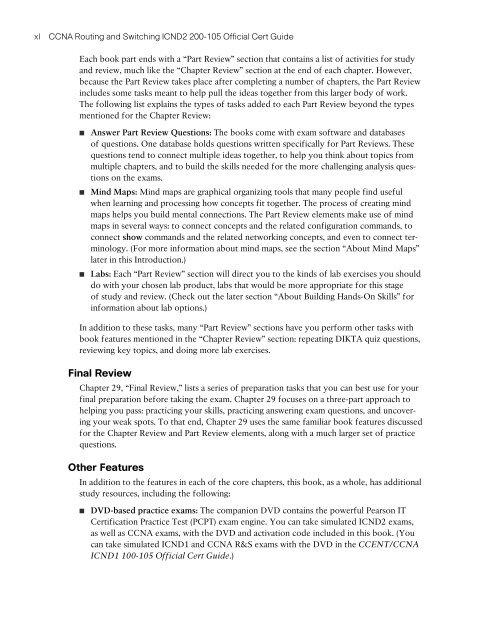CCNA Routing and Switching
HuPe306583u
HuPe306583u
Create successful ePaper yourself
Turn your PDF publications into a flip-book with our unique Google optimized e-Paper software.
xl<br />
<strong>CCNA</strong> <strong>Routing</strong> <strong>and</strong> <strong>Switching</strong> ICND2 200-105 Official Cert Guide<br />
Each book part ends with a “Part Review” section that contains a list of activities for study<br />
<strong>and</strong> review, much like the “Chapter Review” section at the end of each chapter. However,<br />
because the Part Review takes place after completing a number of chapters, the Part Review<br />
includes some tasks meant to help pull the ideas together from this larger body of work.<br />
The following list explains the types of tasks added to each Part Review beyond the types<br />
mentioned for the Chapter Review:<br />
■ Answer Part Review Questions: The books come with exam software <strong>and</strong> databases<br />
of questions. One database holds questions written specifically for Part Reviews. These<br />
questions tend to connect multiple ideas together, to help you think about topics from<br />
multiple chapters, <strong>and</strong> to build the skills needed for the more challenging analysis questions<br />
on the exams.<br />
■ Mind Maps: Mind maps are graphical organizing tools that many people find useful<br />
when learning <strong>and</strong> processing how concepts fit together. The process of creating mind<br />
maps helps you build mental connections. The Part Review elements make use of mind<br />
maps in several ways: to connect concepts <strong>and</strong> the related configuration comm<strong>and</strong>s, to<br />
connect show comm<strong>and</strong>s <strong>and</strong> the related networking concepts, <strong>and</strong> even to connect terminology.<br />
(For more information about mind maps, see the section “About Mind Maps”<br />
later in this Introduction.)<br />
■ Labs: Each “Part Review” section will direct you to the kinds of lab exercises you should<br />
do with your chosen lab product, labs that would be more appropriate for this stage<br />
of study <strong>and</strong> review. (Check out the later section “About Building H<strong>and</strong>s-On Skills” for<br />
information about lab options.)<br />
In addition to these tasks, many “Part Review” sections have you perform other tasks with<br />
book features mentioned in the “Chapter Review” section: repeating DIKTA quiz questions,<br />
reviewing key topics, <strong>and</strong> doing more lab exercises.<br />
Final Review<br />
Chapter 29, “Final Review,” lists a series of preparation tasks that you can best use for your<br />
final preparation before taking the exam. Chapter 29 focuses on a three-part approach to<br />
helping you pass: practicing your skills, practicing answering exam questions, <strong>and</strong> uncovering<br />
your weak spots. To that end, Chapter 29 uses the same familiar book features discussed<br />
for the Chapter Review <strong>and</strong> Part Review elements, along with a much larger set of practice<br />
questions.<br />
Other Features<br />
In addition to the features in each of the core chapters, this book, as a whole, has additional<br />
study resources, including the following:<br />
■ DVD-based practice exams: The companion DVD contains the powerful Pearson IT<br />
Certification Practice Test (PCPT) exam engine. You can take simulated ICND2 exams,<br />
as well as <strong>CCNA</strong> exams, with the DVD <strong>and</strong> activation code included in this book. (You<br />
can take simulated ICND1 <strong>and</strong> <strong>CCNA</strong> R&S exams with the DVD in the CCENT/<strong>CCNA</strong><br />
ICND1 100-105 Official Cert Guide.)


